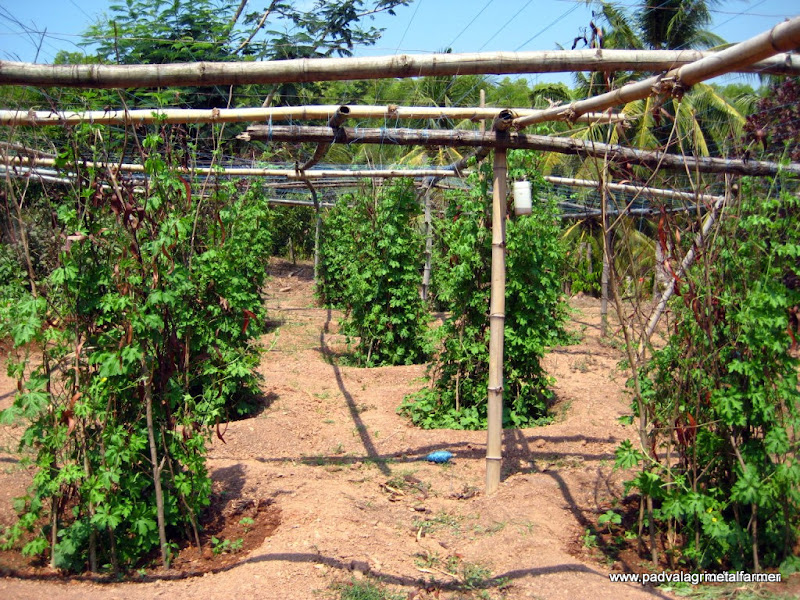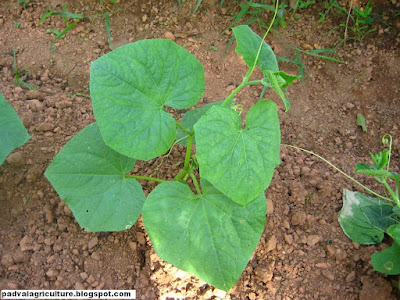Bitter Gourd Cultivation in Continuous Pits by Pritham D'Souza Metal FarmerBitter Gourd (
Momordica charantia) also known as bitter gourd or Karela (hindi), karathe (konkani) and kanchala (tulu) is cultivated in mainly tropical and sub tropical places throughout the world.
The bitter taste is due to the presence of Momorcidin.
The wonder fruit, which is consumed as a vegetable is widely used in traditional medicines and is well known for treatment against diabetes, preventing malaria and constipation. It is also used as an effective bio repellent. however the red arils of the seed (outer red coating) can be toxic to children.
Bitter gourd is an acquired taste, but its medicinal properties make it a commercially viable crop.
Climate and Soil- being a tropical crop, it grows well in temperatures ranging from 28 to 35 degrees celcius
- extreme temperatures not favorable as it will result in spread of mosaic disease caused by virus
- soils have to be well drained and loamy.
Sowing- the seed coat is very hard and unless conditions are favorable, germination will not take place as usual. for this , soaking the seeds in water for a minimum of 24 hours before sowing is recommended to break the seed dormancy
- in some places water is replaced by curds and it also helps in rapid germination as the curds contain bacteria which also break the seed dormancy by softening the hard seed coat
- dried and decomposed farm yard manure is added to the pits just before sowing the seeds
- each pit, about 5 seeds are sowed and after germination 2 plants retained in every pit
- the distance between pits is about 45 cms
Inter Culture Operations- after about 21 days after sowing, the growing tendrils will begin to droop on the ground. this will require support and it being a climber, adequate arrangements need to be made
- here the soil around each plant is gathered around to fortify the pit and organic manure is added to each pit
- then support in the form of long sticks is placed in each pit as shown
- the growing vines are then trained on them and a pendal is erected
- the pits help to prevent excess leaching of water and acts as a retention barrier
- weeding, irrigation and earthing up of the soils are made easier
- moist soils require less irrigation, about once a week, while areas which have direct sunlight, require frequent irrigation.
- pits also help in mulching and prevents loss of water by evaporation
Flowering and Harvest- spraying certain growth hormones such as Ethrel is done to increase the number of felame flowers and has to be done 2 weeks before flowering begins
- during flowering, another dose of farm yard manure or dried and decomposed organic manure is added @ 10 kg per pit
- if the manure is fresh and not properly decomposed, it will injur the roots and stem
- fruits can be harvested after 60 to 75 days from the first day of sowing
- the tender , immature fruits are preferred over ripe fruits
- soon after harvesting, they are washed in water and dried before taking to market
Pests of Bitter Gourd and Treatment- the bitter taste of the fruit prevents it from getting attacked as frequent as the other crops belonging to the cucurbit family, however the major pests include the following
- red pumpkin beetles which are most notorious as if feeds the young and tender leaves during growth stage. also feeds on the flowers .
- Stink Bugs are huge and have a plate of scaly armour to prevent from natural predators attacking it. also it releases a stink liquid which helps it to escape before getting caught. it feeds on tender fruits and results on rotting of the fruit
- aphids and thrips can cause serious damage, while the former can colonise the plant, the latter can feed on the leaves which later curl inside
- leaf eating caterpillar destroy the leaves and skeletonise the plant, the silk cucoons can be seen mostly on lower surface of the leaves
- fruit fly bores on the growing fruit and lays the eggs which grow inside the fruit. worms can be seen in the rotting fruits
Treatmentintegrated farm management practises recommend the use of both organic as well as chemical pesticides for effective control of pests . however since i advocate the use of mostly neem based sprays, i advise the following
- neem cake applied to the soil at 25 day intervals around the plant
- during the growing stage, neem solution is sprayed weekly twice @5 ml per litre water
- during flowering stage , Neem solution is sprayed weekly once @10 ml per litre
- since neem is all natural and non toxic , it can be sprayed on standing crops and when yield is seen
- spray neem preferably in the evenings, when its cooler between 4 to 6 pm
all data and images by Pritham dsouza aka Metalfarmer

















































